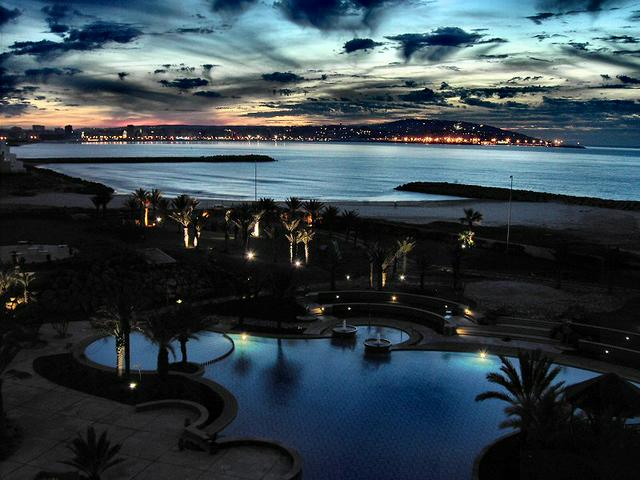 Tangier (Ar. طنجة, Tanjah, Fr. Tanger) is an important port city in Morocco. The third most populous city in the country, due to its proximity to Spain it's a popular entry point to the country and Africa as a whole, and an interesting destination in its own right.
Tangier (Ar. طنجة, Tanjah, Fr. Tanger) is an important port city in Morocco. The third most populous city in the country, due to its proximity to Spain it's a popular entry point to the country and Africa as a whole, and an interesting destination in its own right.
Tangier is a fascinating Moroccan city to visit. It has many of the things that travellers love--a sense of exotic mystery, interesting history, beautiful vistas, unspoiled beaches, and friendly people. It is an interesting mix of the cultures of north Africa, Spain, and France and indeed has a very international history, and has traditionally been home to people from several different cultures. At the beginning of the 20th century, for instance, a quarter of the city's population were Europeans and another quarter Jewish.
Founded sometime in the 5th century BCE, Tangier has been part of all major empires in the region throughout history. During the last centuries major European powers have contested for the city at the southern bank of the Strait of Gibraltar in order to gain control over the traffic between the Atlantic and the Mediterranean. This game even brought France and Germany to the brink of war in 1905. Deemed too important to be controlled by a single country, it was under joint international control from 1925 to 1956 (during that period known as the Tangier International Zone). During World War II and the Cold War it was also major center for spying activities by major powers, as well as a playground for gamblers, crooks and millionaires. Also, several Western cultural personalities such as William S. Burroughs, George Orwell, Matisse and the rock band Rolling Stones have spent some time in Tangier though the most prominent of them was the American author Paul Bowles who lived there for most of his life.
Today the city with a little less than a million inhabitants is the third largest city in Morocco, an important port, center of industry and a popular destination for daytrippers. Frequent ferries make the short crossing from Europe each day, and many cruise ships sailing between the Mediterranean and the Atlantic often include Tangier as a port of call. The Spanish coastline, 30 km away can be seen unless there's haze or fog.
Quite appropriately, Tangier is the birthplace of Ibn Battuta, considered by many to be one of the greatest travellers of all time and on a level with the Venetian Marco Polo. This Berber visited most of the "known" world at that time including most African regions north of Uganda and Eurasia as far as China.
The northwest of Morocco is the wettest part of the country. Compared to the south of the country, the summers are milder and the winters can be relatively cold. Facing the Atlantic directly, temperatures in Tangier are usually even a couple degrees cooler than at the Spanish side of the strait.
- Medina — the old town of Tangier is quite compact compared to the likes in other Moroccan cities. Still, it's easy to lose your orientation in its labyrinths of alleys. Landmarks include the Grand Mosque and several souks (markets).
- Kasbah — the northwestern part of the medina is made up of the Kasbah or fortification. The main building here is the Dar el-Makhzen that has served as residence for sultans and European colonial lords. Today it is a museum.
- Ville Nouvelle — the new city around Boulevard Pasteur is the commercial center of Tangier. Though not an attraction in any sense, it's where to go to find banks, cafés, modern shops and such.
Medina — the old town of Tangier is quite compact compared to the likes in other Moroccan cities. Still, it's easy to lose your orientation in its labyrinths of alleys. Landmarks include the Grand Mosque and several souks (markets).
Kasbah — the northwestern part of the medina is made up of the Kasbah or fortification. The main building here is the Dar el-Makhzen that has served as residence for sultans and European colonial lords. Today it is a museum.
Ville Nouvelle — the new city around Boulevard Pasteur is the commercial center of Tangier. Though not an attraction in any sense, it's where to go to find banks, cafés, modern shops and such.
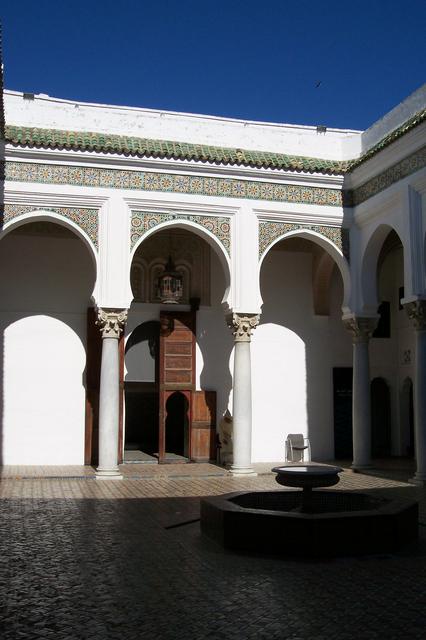 Tangier is a city where there are rather few individual sights. Instead, the whole city can be considered one single big sight. Take a simple walk along the beach (Ave Mohamed VI) to enjoy what the city is famed for. In the port. you can see fishing boats bringing in fresh fish everyday. There are also restaurants serving very fresh fish. Moreover, here you can also see the frequent fast ferries arriving from and departing to Tarifa.
Tangier is a city where there are rather few individual sights. Instead, the whole city can be considered one single big sight. Take a simple walk along the beach (Ave Mohamed VI) to enjoy what the city is famed for. In the port. you can see fishing boats bringing in fresh fish everyday. There are also restaurants serving very fresh fish. Moreover, here you can also see the frequent fast ferries arriving from and departing to Tarifa.
The medina., ie. the old town is probably Tangier's biggest attraction. Its narrow streets and many businesses are a quite interesting experience. You will very likely get lost, though. Also, be aware that both touts on the street and shopkeepers are very eager at selling you everything from fezzes and bracelets to mats and fake Rolexes (also see the stay safe section below).
Landmarks in the medina include Grand Mosquee, the nearby petit souk and the fortress (Kasbah).
- Grande Mosquée. A large mosque built in the 17th century, with its minaret rising above the city walls towards the sea. It's not the first place of worship on that place, before the mosque there has been a cathedral and a Roman temple.
- Petit souq. The "small market" was at one point one of the greatest market places in Morocco. In the early 20th century which was the heyday of the city, wealthy people settled in the area around petit souq, and with them came cafés, hotels and casinos but also offices of banks and other offices. These times are over, and many businesses have relocated to newer parts of the city but it can still be considered the heart of the medina, if mainly for tourists nowadays.
- Kasbah. The Kasbah and the Kasbah Museum, the former Sultan's palace deserves to be seen not only for its collection of artefacts from the Phoenician to modern times, but also for the building and garden. There is a small entry fee (20 dirham as of April 30, 2017) and varying opening times winter and summer. The terrace at the northern side of the Kasbah is the place to go for good views over the port, and if there isn't fog or haze, even the Spanish coast.
- The tomb of Ibn Battouta. A 14th century famous traveller who was born in Tangier.
- The American Legation Museum (TALM), 8, Rue America. Cultural center, museum, conference center and library in the heart of the old medina is housed in the only historic landmark of the United States located abroad. The museum exhibits a large collection of art and historical items. It also has a Paul Bowles Wing dedicated to the writer and composer who lived most of his adult life in Tangier. (Morocco was the first country to recognize the United States, in December 1777 with the hope of promoting commerce with the new republic. This act by the Moroccan sultan was the first public recognition of the U.S. by a head of state.) 20 dirham.
- Church of the Immaculate Conception. Built by the Spanish in the 1870s in modernist style, this is the main place of worship for Tangier's Christian community.
- Fondation Lorin, Rue Abdallah Ben Hachimi 44. An art museum, or maybe rather an archive related to the history of Tangier opened in 1930 in a former synagogue. In addition to art, there are newspapers, photographs and posters on display.
The medina., ie. the old town is probably Tangier's biggest attraction. Its narrow streets and many businesses are a quite interesting experience. You will very likely get lost, though. Also, be aware that both touts on the street and shopkeepers are very eager at selling you everything from fezzes and bracelets to mats and fake Rolexes (also see the [[#Stay safe|stay safe section below]]).
Grande Mosquée. A large mosque built in the 17th century, with its minaret rising above the city walls towards the sea. It's not the first place of worship on that place, before the mosque there has been a cathedral and a Roman temple.
Petit souq. The "small market" was at one point one of the greatest market places in Morocco. In the early 20th century which was the heyday of the city, wealthy people settled in the area around petit souq, and with them came cafés, hotels and casinos but also offices of banks and other offices. These times are over, and many businesses have relocated to newer parts of the city but it can still be considered the heart of the medina, if mainly for tourists nowadays.
Kasbah. The Kasbah and the Kasbah Museum, the former Sultan's palace deserves to be seen not only for its collection of artefacts from the Phoenician to modern times, but also for the building and garden. There is a small entry fee (20 dirham as of April 30, 2017) and varying opening times winter and summer. The terrace at the northern side of the Kasbah is the place to go for good views over the port, and if there isn't fog or haze, even the Spanish coast.
The tomb of Ibn Battouta. A 14th century famous traveller who was born in Tangier.
The American Legation Museum (TALM), 8, Rue America. Cultural center, museum, conference center and library in the heart of the old medina is housed in the only historic landmark of the United States located abroad. The museum exhibits a large collection of art and historical items. It also has a Paul Bowles Wing dedicated to the writer and composer who lived most of his adult life in Tangier. (Morocco was the first country to recognize the United States, in December 1777 with the hope of promoting commerce with the new republic. This act by the Moroccan sultan was the first public recognition of the U.S. by a head of state.) 20 dirham.
Church of the Immaculate Conception. Built by the Spanish in the 1870s in modernist style, this is the main place of worship for Tangier's Christian community.
Fondation Lorin, Rue Abdallah Ben Hachimi 44. An art museum, or maybe rather an archive related to the history of Tangier opened in 1930 in a former synagogue. In addition to art, there are newspapers, photographs and posters on display.
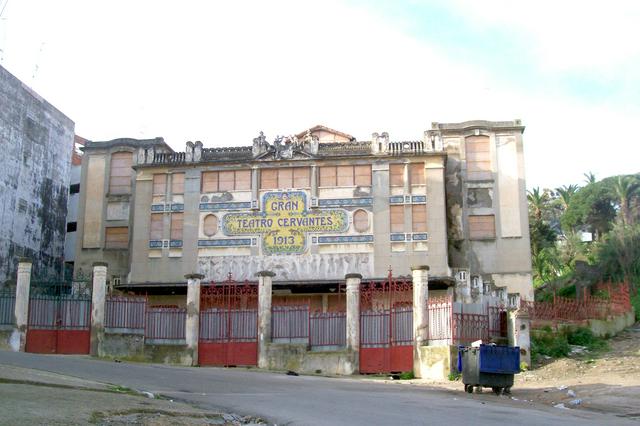
- Place du 9 Avril 1947. A large lively park-like square just southwest of the medina. Next to it there's the Sidi Bou Abib Mosque. Go to the souk on Thursday or Sunday mornings to see the Rif mountain women in their colorful costumes selling their produce and dairy products all along the wall of the St. Andrew's Church (English Church).
- Sidi Bou Abib Mosque. Built in 1917 and decorated with polychrome tiles, this is the mosque right next to the grand socco.
- Church of Saint Andrew. After the first Anglican church got too small, the current one was built behind the Sidi Bou Abib mosque. The church is built in Moorish style and the belltower is shaped like a minaret. In the graveyard next to the church rests prominent British figures in the history of the city, including the officers Sir Harry MacLean and Roy Howell with his wife Claire de Menasce, the criminal Paul Lund and writer Walter Burton Harris. There's also a plaque commemorating Emily Keene, who introduced the cholera vaccine to Morocco (her grave is elsewhere).
- Mendoubia Gardens. The continuation of the grand socco to the west, this garden features a large marble fountain and park benches.
- Gran Teatro Cervantes, rue Salah Eddine et Ayoubi. Closed and falling to pieces but take a photo from outside the gates as you pass by on the way up to the Grand Socco.
- Museum of Contemporary Art, Boulevard d'Angleterre 52. Museum showcasing Moroccan modern art, mostly traveling exhibitions.
Place du 9 Avril 1947. A large lively park-like square just southwest of the medina. Next to it there's the Sidi Bou Abib Mosque. Go to the souk on Thursday or Sunday mornings to see the Rif mountain women in their colorful costumes selling their produce and dairy products all along the wall of the St. Andrew's Church (English Church).
Sidi Bou Abib Mosque. Built in 1917 and decorated with polychrome tiles, this is the mosque right next to the grand socco.
Church of Saint Andrew. After the first Anglican church got too small, the current one was built behind the Sidi Bou Abib mosque. The church is built in Moorish style and the belltower is shaped like a minaret. In the graveyard next to the church rests prominent British figures in the history of the city, including the officers Sir Harry MacLean and Roy Howell with his wife Claire de Menasce, the criminal Paul Lund and writer Walter Burton Harris. There's also a plaque commemorating Emily Keene, who introduced the cholera vaccine to Morocco (her grave is elsewhere).
Mendoubia Gardens. The continuation of the grand socco to the west, this garden features a large marble fountain and park benches.
Gran Teatro Cervantes, rue Salah Eddine et Ayoubi. Closed and falling to pieces but take a photo from outside the gates as you pass by on the way up to the Grand Socco.
Museum of Contemporary Art, Boulevard d'Angleterre 52. Museum showcasing Moroccan modern art, mostly traveling exhibitions.
- Palais Marshan. This impressive building is nowadays a government-owned residence for visitors. Until 1990 it served as a museum of historical battles with statues of soldiers on different battlefields. The building was also featured in the James Bond movie The Living Daylights.
- Plaza de Toros. Built by the Spanish (who else?) in the 1940s, this is the last remaining bullring in Morocco. The last bullfight took place in 1970, after that the place has been more or less abandoned, though still a notable historic site.
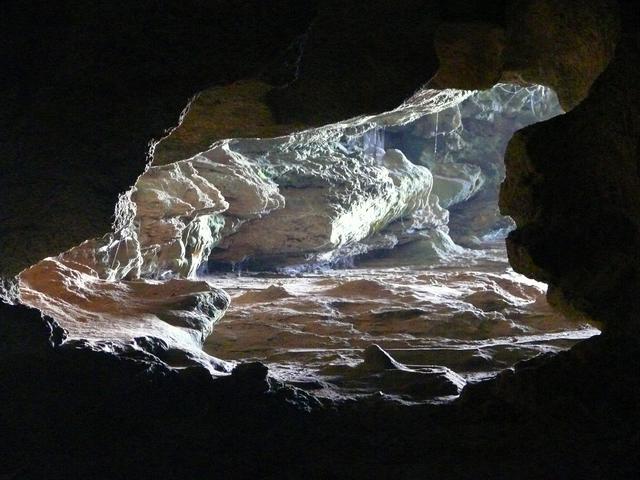
- Hercules Caves. The caves are a place of stunning natural beauty and great archeological significance. Apparently, this is where the mythical figure, Hercules, used to rest after finishing his 12 labours. The cave also bears a mirror image resemblance to the continent of Africa. 10 dirham, but do not bother with an additional tour guide.
- Cap Malabata. A great place for watching the sunrise and experiencing North African countryside.
Palais Marshan. This impressive building is nowadays a government-owned residence for visitors. Until 1990 it served as a museum of historical battles with statues of soldiers on different battlefields. The building was also featured in the James Bond movie The Living Daylights.
Plaza de Toros. Built by the Spanish (who else?) in the 1940s, this is the last remaining bullring in Morocco. The last bullfight took place in 1970, after that the place has been more or less abandoned, though still a notable historic site.
Hercules Caves. The caves are a place of stunning natural beauty and great archeological significance. Apparently, this is where the mythical figure, Hercules, used to rest after finishing his 12 labours. The cave also bears a mirror image resemblance to the continent of Africa. 10 dirham, but do not bother with an additional tour guide.
Cap Malabata. A great place for watching the sunrise and experiencing North African countryside.
Tangier is a city where there are rather few individual sights. Instead, the whole city can be considered one single big sight. Take a simple walk along the beach (Ave Mohamed VI) to enjoy what the city is famed for. In the port. you can see fishing boats bringing in fresh fish everyday. There are also restaurants serving very fresh fish. Moreover, here you can also see the frequent fast ferries arriving from and departing to Tarifa.
Walk around the city. Get happily lost in the medina, which is most active in evening and night. Alternatively walk along Boulevard Pasteur with its view to the sea from Terrasse des Paresseux or the beachfront Avenue Mohammed VI and in the port area and look at the fishermen bringing in their catch. When walking around, there are plenty of opportunities for shopping, described in the next section.
For nice views of the city and the seas, head to the aforementioned Terrasse des Paresseux, Kasbah or to the famous Café Hafa in the Drink section.
- Mnar Park. Aquatic park with a tremendous view of the coast. Open in 2005 it costs €5 for children and €10 Adults has aqua slides, karting circuits, café, romantic restaurant with excellent pancakes.
- Tanjazz. Jazz festival with artists from all over the world performing. It comprises both large outdoor concerts at large squares in the city and smaller ones at indoor locations. Held yearly.
- Tangier Pocket City-Guide is a free monthly magazine that presents addresses and cultural events of the Northern Region of Morocco, on paper, or online, or via the Android Tangier Pocket app.
Tanjazz. Jazz festival with artists from all over the world performing. It comprises both large outdoor concerts at large squares in the city and smaller ones at indoor locations. Held yearly.
Mnar Park. Aquatic park with a tremendous view of the coast. Open in 2005 it costs €5 for children and €10 Adults has aqua slides, karting circuits, café, romantic restaurant with excellent pancakes.
The medina is full of small shops, though beware that some of them are tourist traps and salesmen are seemingly outright desperate to get you to buy stuff you really are not interested in. Much of the brasswork is made in other towns but is available here. Leather goods are also available. Stay away from the tourist traps and you may find the price quite agreeable. Colorful leather slippers, men's and women's clothing can be had for reasonable prices too. When shopping here, bargaining is essential, there are really no fixed prices. It is advisable to negotiate prices in dirham rather than euros.
- Casa Barata. Sa-Th. There is a infamous market 6 km outside Tangier called "casa barata" (the house of cheap things). There are bargains to be had here but be wary of forgeries and stolen goods (these are sold alongside vegetables, electronics, clothing, shoes, spices, carpets, ironmongery and everything else one can think of!). You can take a grand taxi from the station just next to English Church. It's just 5 minutes ride by taxi and the fare is 3 dirham each person.
There are other markets notably the souk in the medina (mainly vegetables, clothes and tourist items) and in Ben Mekada (vegetables). The latter does not cater for tourists at all and is known as one of the "rough spots" of Tangier and back in the 1980s there were bread riots here.
Casa Barata. Sa-Th. There is a infamous market 6 km outside Tangier called "casa barata" (the house of cheap things). There are bargains to be had here but be wary of forgeries and stolen goods (these are sold alongside vegetables, electronics, clothing, shoes, spices, carpets, ironmongery and everything else one can think of!). You can take a grand taxi from the station just next to English Church. It's just 5 minutes ride by taxi and the fare is 3 dirham each person.
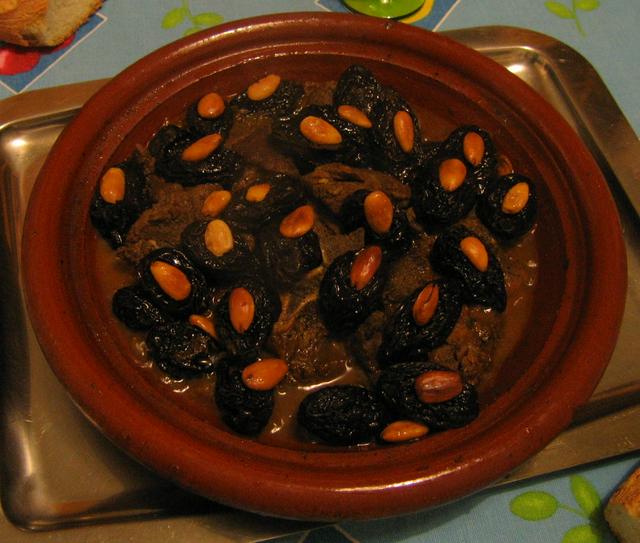
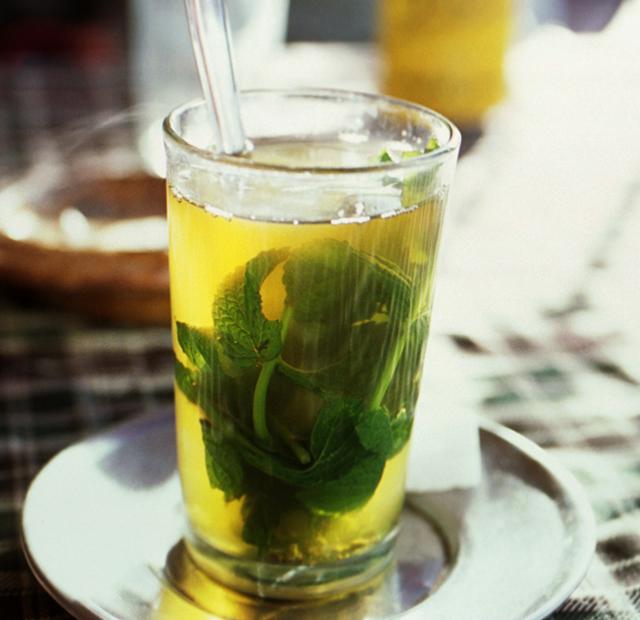 There are restaurants serving most major cuisines in Tangier. Though while you're here, why not try out the specialties of Maghreb; different types of tagines (stews) and couscous as well as mint tea?
There are restaurants serving most major cuisines in Tangier. Though while you're here, why not try out the specialties of Maghreb; different types of tagines (stews) and couscous as well as mint tea?
In the morning a "locals" cafe will give you a cafe au lait for 5 dirham. (Cafes where tourists congregate will charge you 10 dirham.) Usually there is a bread vendor at the cafe (by the port or the madina) who will serve you bread with cheese and honey for another 5 dirham. It's perfectly okay to buy your bread/breakfast elsewhere and eat it outside at the cafe. If the bread guy is next to the cafe the waiter will often collect.
You may quickly bore of tagines and street food is a great option for snacking throughout the day. Fresh orange juice costs about 5 dirham; sandwiches of egg, peppers, and sauce are about 10 dirham. Yogurt mixtures can be particularly creative, such as avocado and almonds, or fruit mixtures. Tiny stalls in the souk sell cooked vegetables like eggplant, with rice, and other tasty treats and a meal there can cost 10 dirham or so. In the early evening you may find squares of chickpea cakes sprinkled with salt and paprika.
In the evening, go to the plaza next to CTM bus station. There are several cafes and restaurants facing the plaza. The price and services are good because of the keen competition. Just wandering around in the medina will bring you across numerous Moroccan restaurants offering similar dishes, quality, and prices (main dish around 7 dollars), so you can basically just choose one at random and probably be satisfied.
Vegetarians will find plenty to eat in Tangier and Morocco in general, but vegetarian tagines can become boring after a couple of days and often contain lamb stock. Street food is a lot more creative and fun. If you've brought a camping stove, shop at the souk and make your own. Though, do remember to wash the fruits well. Or you can opt for pizza, Chinese or Indian all of which are available in Tangier.
Tap water isn't dangerous, but for visitors it is much safer (and inexpensive) to drink bottled water.
There are some fresh off-the-boat seafood restaurants for locals in the port behind the warehouses. At the port entrance, walk towards the water and keep to the right. It's on the docks towards the farthest point out behind some buildings; all outdoor seating for the most part. Order a tray of shrimp, a (big) salad and the calamari and fish tray. No menus or prices but it's quite inexpensive and authentic. For about 60 dirham you will get a serving of fish and seafood for one person that could easily feed two, including salad, bread and beverages.
Many cafes also serve snacks and many bars on the beachfront serve tapas. Also, some familiar global fast food brands have restaurants in Tangier.
- Brahim Abdelmalek, Rue Mexique (a block away from Terrasse des Paresseux. Fast food. A fabulous and cheap sandwich of kefta, egg, fries on a baguette at around 14 Dhs
- L'association Darna, rue Jules Cot - Place du 9 avril (from the main square, go uphill and take the stairs leading down to a large building with a large green gate., +212 5 39 94 70 65. The Darna organization helping women and children in difficulties is operating a restaurant, popular among the western expats in the city. four-course menu 47 dirham.
- Oslo, Boulevard Mohammed V (located on the Boulevard and on the beachfront. Pizzas and snacks.
- Cafe A L'anglaise, 37 rue de la Kasbah (From the Place of 9 april take the street ( Rue d'Italie) that starts in the arcade of the Kasbah. The street will go up of the hill. The cafe is next to the pastries chop. If you come from the museum of the kasbah walk down a little the cafe is just after the pharmacy., +212 635-186766. 1AM-10PM. In the heart of the Kasbah on the highest peak of the Medina of Tangier with panoramic views, It is has a range of veggie meals and all dishes are cooked in traditional wood oven. It is 100% organic. The juice comes huge with no additive and some fresh ginger and pomme grenade. €8.
Brahim Abdelmalek, Rue Mexique (a block away from Terrasse des Paresseux. Fast food. A fabulous and cheap sandwich of kefta, egg, fries on a baguette at around 14 Dhs
L'association Darna, rue Jules Cot - Place du 9 avril (from the main square, go uphill and take the stairs leading down to a large building with a large green gate., +212 5 39 94 70 65. The Darna organization helping women and children in difficulties is operating a restaurant, popular among the western expats in the city. four-course menu 47 dirham.
Oslo, Boulevard Mohammed V (located on the Boulevard and on the beachfront. Pizzas and snacks.
Cafe A L'anglaise, 37 rue de la Kasbah (From the Place of 9 april take the street ( Rue d'Italie) that starts in the arcade of the Kasbah. The street will go up of the hill. The cafe is next to the pastries chop. If you come from the museum of the kasbah walk down a little the cafe is just after the pharmacy., +212 635-186766. 1AM-10PM. In the heart of the Kasbah on the highest peak of the Medina of Tangier with panoramic views, It is has a range of veggie meals and all dishes are cooked in traditional wood oven. It is 100% organic. The juice comes huge with no additive and some fresh ginger and pomme grenade. €8.
- Saveurs de poissons - Chez Poppeye, Escalier Waller, 2 (near rue de la Liberté and the hotel El-Minzah, +212 5 39 33 63 26. Excellent seafood and fish restaurant, served with some kind of couscous and tajine as is typical in Morocco. Fruit juice is also a speciality. 100-150 dirham.
- Le Pagode, 3 rue El Boussairi (located near the town centre. Chinese and Vietnamese restaurant with pleasant decor and friendly service. The food has received mixed reviews.
- Otori Sushi, 41 Av. de la Resistance (located near the Grande Poste, +212 5393 25533. According to many reviewers the best Japanese food in Tangier, especially sushi. about 120 dirham/person.
- Restaurant Al Andalous, Rue Hafid Ben Abdel-Barr (opposite the Al Andalous Mosque, Lalla Chafia.. Moroccan Deli & Fish Bar with nice decor and typical Moroccan dishes.
Saveurs de poissons - Chez Poppeye, Escalier Waller, 2 (near rue de la Liberté and the hotel El-Minzah, +212 5 39 33 63 26. Excellent seafood and fish restaurant, served with some kind of couscous and tajine as is typical in Morocco. Fruit juice is also a speciality. 100-150 dirham.
Le Pagode, 3 rue El Boussairi (located near the town centre. Chinese and Vietnamese restaurant with pleasant decor and friendly service. The food has received mixed reviews.
Otori Sushi, 41 Av. de la Resistance (located near the Grande Poste, +212 5393 25533. According to many reviewers the best Japanese food in Tangier, especially sushi. about 120 dirham/person.
Restaurant Al Andalous, Rue Hafid Ben Abdel-Barr (opposite the Al Andalous Mosque, Lalla Chafia.. Moroccan Deli & Fish Bar with nice decor and typical Moroccan dishes.
Many of the luxury hotels, including the iconic Hotel Continental, offer a good selection of both Moroccan and continental fare, though at prices much higher than what you will find elsewhere. There are also many restaurants along the Ave Mohamed VI (the beachfront) where one can enjoy a nice meal with a glass of wine on the beachfront.
- Marhaba Palace Restaurant, Place du Tabor. Moroccan restaurant with Moroccan ambience. Four course lunch alternatives. Apparently popular with tour groups. 4 course lunch menus €17 and €24.
- San Remo, 15 Rue Ahmed Chouki (located near the town centre, +212 5399 38451. Italian and French cuisine, apparently decent food at elevated prices. mains around 150 dirham.
Marhaba Palace Restaurant, Place du Tabor. Moroccan restaurant with Moroccan ambience. Four course lunch alternatives. Apparently popular with tour groups. 4 course lunch menus €17 and €24.
San Remo, 15 Rue Ahmed Chouki (located near the town centre, +212 5399 38451. Italian and French cuisine, apparently decent food at elevated prices. mains around 150 dirham.
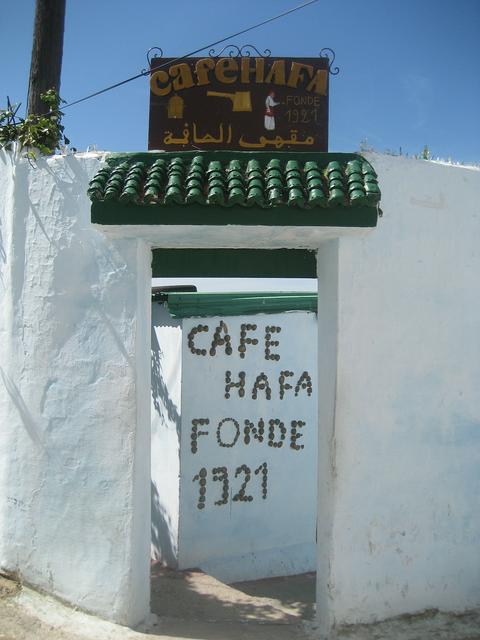 There are many places in Tangier to drink. Much depends on the current owner who tends to give the place a certain ambiance. Popular bars/discos with foreign (and local) clientele include Casa Pepe, Sable D'or, Morocco Palace, Marco Polo (popular with truck drivers) and hotel bars such as Ramada and El Minzah.
There are many places in Tangier to drink. Much depends on the current owner who tends to give the place a certain ambiance. Popular bars/discos with foreign (and local) clientele include Casa Pepe, Sable D'or, Morocco Palace, Marco Polo (popular with truck drivers) and hotel bars such as Ramada and El Minzah.
You could opt for a coffee, and there are no shortage of cafes; some of which are the best in the country. Some have amazing views (cafe Hafa), some good coffee, some are popular (cafe Tropicana, cafe Celine Dion), some with music (cafe in the Dawliz complex), some have good cakes (cafe Oslo), some are places to relax after a hard day shopping (cafe Madam Porte, cafe Vienna), and some are rather sleazy.
Fresh fruit juices are sold by street vendors during the summer months. The cafes also serve fresh fruit juices and often have wpanache, a delicious mix of fruit juices often with milk, apple and almond.
- Cafe El-Hafa. Opened in 1921, visited by famous writers and artists. View on the Straits of Gibraltar. Drink tea while looking at boats passing by.
- Bar Tangerine, Rue Magellan 1. Nice little bar for a drink in the evening or the weekend.
- La Fuga, Rue Ibn Zaidoun. Café and pizzeria.
- La Española, 97,Rue La Libérté. Bakery and tea house, specializing in cakes.
Cafe El-Hafa. Opened in 1921, visited by famous writers and artists. View on the Straits of Gibraltar. Drink tea while looking at boats passing by.
Bar Tangerine, Rue Magellan 1. Nice little bar for a drink in the evening or the weekend.
La Fuga, Rue Ibn Zaidoun. Café and pizzeria.
La Española, 97,Rue La Libérté. Bakery and tea house, specializing in cakes.
Generally, central Tangier is a very safe city compared with many places in Europe though this does not necessarily apply to the suburbs. The only trouble you may encounter are the persistent touts whom you should ignore, or the con-men ready to fleece you (by trying to chat up to you then sometimes offer to smoke hashish), and you will encounter these almost exclusively in the medina. There are policemen everywhere and you will probably feel safer than at home. Tangier is generally safe for lone women.
Dressing like a local will help you blend in and get good reception from merchants, who will often quote you actual prices instead of inflated tourist prices. There are lots of expats in this city that speaks Spanish first, then English and then French. A polite no thank you and then simply ignoring touts does get rid of them.
This is not the case if you are visiting Tangier as part of a tour (e.g. a day tour from Costa del Sol or a cruise excursion). In this case, as of May 2015, the souvenir touts are going to follow your group during the whole time you're in the medina. Yes, they may have interesting looking stuff for sale, but if you buy anything from anyone of them it will mark you as an easy target and the other ten touts in the gang will surround you until you get back on the tour bus. Save your shopping for the shops, which you will stop at. They are also eager to get to sell you something, but they do at least have a larger selection and won't follow you along.
If you are lost in the medina, you can easily find your way out by going uphill (souk/English church/Nouvelle Village) or down (port). Children and young men may ask you for money to lead you out (a couple of dirams), or to the Cafe Central, but if you are asked if you are lost and do not want help, say "Yes, but happily," and usually that gets a laugh and solitude.
- Asilah — Town at the ocean with a splendid white medina and a lots of beaches, 20 km south. Grand taxi 50 dirham, bus 11 dirham.
- Larache — A lively and non-touristy town 85 km to the south featuring beaches and the Phoenician-Roman ruins of Lixus at the estuary of river Loukkos.
- Chefchaouen — Some 120 km southeast. This is a traditional Rif mountain village with blue and white houses surrounded by beautiful forested countryside.
- Tetouan — The other major city in the region, 60 km to the southeast. It has what some people call the prettiest medina of the country, which is also a UNESCO World Heritage Site. The coast further east features sand beaches, resorts and good diving.
- Ceuta — 65 km northeast, this is a Spanish enclave on the African mainland. The road there passes Jbel Musa which in antiquity was known as one of the Pillars of Hercules (the other one was the Rock of Gibraltar)
- Mainland Spain — You can buy train, bus and ferry tickets at the stations and ports listed above, although you may find it easier to purchase ferry tickets from travel agents rather than face the gauntlet of touts at the port. If you plan on leaving by ferry, it is important to note that the ferries from Tanger Med to Algeciras often do not follow a set schedule, and departure times can change even within a day of having purchased tickets. One alternative is to take a fast ferry to Tarifa, because these are more likely to run on time and at least one of the companies provides a free bus to the port at Algeciras. You can also flag grand taxis at the major bus stations and ferry port. If you're leaving Morocco, spend or exchange your dirham to another currency first. Legally, you may not bring out more than 1000 dirham, and you will probably not be able to exchange them abroad.
- Otherwise, buses and trains take you south to other major cities in Morocco such as Rabat, Marrakech and Casablanca.
